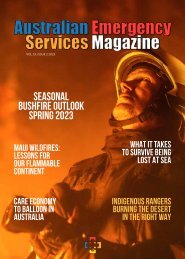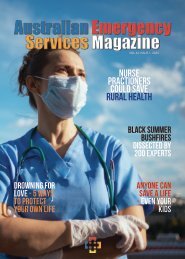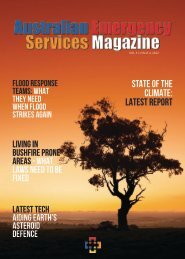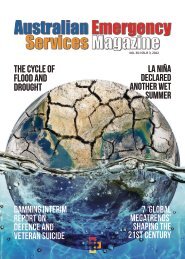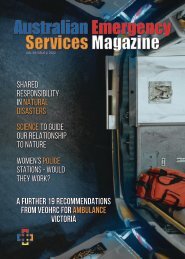Vol. 8 Issue 3. 2018
The Australian Emergency Services Magazine is a community educational resource dedicated to the recognition and promotion of emergency service personnel, and the awareness of safety measures, for the community, family and individual. We aim to provide relevant and up to date information and advancements within each of the emergency response sectors and first responders.
The Australian Emergency Services Magazine is a community educational resource dedicated to the recognition and promotion of emergency service personnel, and the awareness of safety measures, for the community, family and individual. We aim to provide relevant and up to date information and advancements within each of the emergency response sectors and first responders.
Create successful ePaper yourself
Turn your PDF publications into a flip-book with our unique Google optimized e-Paper software.
Winter <strong>2018</strong> <strong>Vol</strong> 8<br />
ESTA’S<br />
TRIPLE<br />
ZERO<br />
HEROES<br />
WINTER<br />
IS HERE<br />
Your<br />
Weather<br />
Update<br />
COMPASSION FATIGUE<br />
Is it a myth ?
CONTENTS<br />
Editor’s Note<br />
2<br />
Latest Events<br />
• Emergency Services Blood<br />
Challenge<br />
• ESTA’s Triple Zero Heroes<br />
• <strong>2018</strong> Search & Rescue Awards<br />
Winter is coming - weather<br />
update<br />
Blaze Aid - <strong>Vol</strong>unteer group<br />
Lessons of resilience - Hobart<br />
floods<br />
The effect of a home model in<br />
elderly care<br />
Accountability within the<br />
Australian Intelligence<br />
Community<br />
Hospital environmental footprint<br />
Globalisation & Infectious Disease<br />
The myth of compassion fatigue<br />
3<br />
4<br />
7<br />
8<br />
13<br />
14<br />
18<br />
21<br />
24<br />
28<br />
32<br />
View from Mt Hotham in Winter<br />
DISCLAIMER<br />
The Australian Emergency Services Magazine is a community<br />
educational resource and does not promote itself as a charity or<br />
fund raising institution, nor solicit on behalf of charities and is no<br />
way financially supported by or associated with any government or<br />
similar institution. Distributions of the publication is Quarterly and<br />
are circulated via a database of interested parties, including business,<br />
subscribers, advertisers, volunteer emergency organistations,<br />
and council libraries. A digital eMag is distributed to a targeted<br />
database in each State & Territory. All information published in<br />
the Australian Emergency Services Magazine is in good faith and<br />
whilst every effort is made to ensure that the publication is free of<br />
error and omission, no responsibility or liability will be accepted by<br />
Boothbook Pty Ltd.<br />
Published by Boothbook Media<br />
ABN:72 605 987 031<br />
www.aesj.com.au<br />
MAGAZINE CONTACTS<br />
1300 851 710<br />
press@aesj.com.au<br />
Suite 112, Locked Bag 1<br />
Robina TC, QLD 4230
EDITORS NOTE<br />
Welcome to the Winter edition of<br />
the Australian Emergency Services<br />
Magazine. There is certainly never<br />
a shortage of things happening and<br />
this edition is as usual full of some<br />
interesting and relevant articles.<br />
We are definitely feeling the cold<br />
blast that recently blustered its way<br />
through the southern states with<br />
snow falling in unusual places yet<br />
again this year. Climate change<br />
can certainly be seen through the<br />
changing of the seasons. Either<br />
the lateness of Summer storms and<br />
cyclone season and the unseasonable<br />
early frosts or hot winter days.<br />
Those keen weather watchers and<br />
our farmers know what Im talking<br />
about. Regardless of this latest<br />
cold blast it seems we are in for a<br />
mild winter this year, according to<br />
weather experts at the Bureau of<br />
Meteorology.<br />
This winter brings another round<br />
of the Emergency Services Blood<br />
Challenge held annually. Get behind<br />
this great cause and support those<br />
you know in the services with an<br />
extra cup of tea and a biscuit!<br />
ESTA’s Triple Zero Heroes were also<br />
announced in the last two months.<br />
There are some amazing stories<br />
of some very brave young people<br />
looking out for others and having<br />
the confidence and quick thinking to<br />
call 000. You can read about them in<br />
this issue.<br />
To help your children feel confident<br />
if faced with such a circumstance a<br />
great resource is a game called the<br />
kids triple zero challenge. You can<br />
download this from the App store or<br />
Google play.<br />
Kids will learn about getting help by<br />
playing games and solving mysteries.<br />
They’ll learn about safety messages<br />
and hear what happens when you<br />
call Triple Zero. Along the way<br />
they will meet the “Zeros” as they<br />
are guided step by step through the<br />
game. For more information on this<br />
visit:<br />
www.kids.triplezero.gov.au<br />
Stay warm and look after each other.<br />
Happy reading,<br />
Emma Parker<br />
Editor
LATEST NEWS<br />
JUNE 1ST - 31ST AUGUST<br />
www.donateblood.com.au/emergency-services-challenge<br />
This winter, Police, Fire, Ambulance<br />
and the SES are again competing<br />
by service and state to give the<br />
most blood donations during<br />
the Emergency Services Blood<br />
Challenge <strong>2018</strong>.<br />
Last year, they made an amazing<br />
9,422 donations altogether. Since<br />
each donation saves up to three lives,<br />
that’s up to 28,266 lives saved.<br />
Congratulations to Victoria Police<br />
who made the most donations last<br />
year.<br />
Who will take the title in <strong>2018</strong>?<br />
Join the challenge and help your<br />
crew beat the other states and<br />
services.<br />
HOW TO GET INVOLVED<br />
Simply join the Red Cross Blood<br />
Service’s group donation program,<br />
Red25, and donate during the<br />
challenge.<br />
Register for the self-service system,<br />
a secure convenient place where<br />
you can manage your details, group<br />
memberships and appointments.<br />
ONCE REGISTERED<br />
To join or change your Red25 group:<br />
select the ‘Red25 group’ tab, search<br />
for the group you wish to join, select<br />
the group and click to submit.<br />
To make an appointment: select<br />
the ‘Appointment’ tab and follow<br />
the prompts through to making a<br />
donation appointment for between 1<br />
June–31 August.<br />
Give blood to have your donation<br />
automatically added to your group’s<br />
tally.<br />
Track your group’s results online<br />
during the challenge, visit the<br />
challenge page.<br />
Encourage your peers to get involved<br />
too! You can download posters,<br />
email templates, social media images<br />
and more, to help you get the word<br />
out.<br />
To arrange a group donation<br />
appointment call 1300 886 524.
LATEST NEWS<br />
ESTA’s Triple Zero Heroes with ESTA’s CEO Marty Smyth, Victorian Minister for Emergency Services, James Merlino, Victorian Minister for<br />
Health, Jill Hennessy, Brownlow Medallist and Channel 9 presenter Shane Crawford.<br />
ESTA’S TRIPLE ZERO HEROES<br />
A total of 31 young Victorians aged<br />
between four and 13 were named Junior<br />
Triple Zero Heroes by the Emergency<br />
Services Telecommunications Authority<br />
(ESTA), for calling triple zero.<br />
The young heroes are nominated by<br />
the ESTA operators who took their<br />
call. The awards, which are in their<br />
fourteenth year, recognise young people<br />
for their bravery and clear thinking in<br />
emergencies.<br />
This year’s heroes include:<br />
Four-year-old Charlotte who called<br />
triple zero when her mum fell and was<br />
unable to move. She explained what was<br />
happening to our operator and cared for<br />
her mother until paramedics arrived<br />
13-year-old Trinity who was out on a<br />
drive with her mum when they ended<br />
up on the edge of a collapsing road.<br />
Trinity escaped and called triple zero<br />
as the car fell 30 metres off a cliff with<br />
her mum still inside. Trinity remained<br />
calm and provided vital details to our<br />
operator until help arrived<br />
Five-year-old Aoife who called triple<br />
zero when her mum collapsed and then<br />
stopped breathing. Aoife performed<br />
CPR on her mum and did a great job of<br />
caring for her mum and younger sibling<br />
until help arrived.<br />
The Minister for Emergency Services,<br />
James Merlino, said: “ESTA’s triple zero<br />
operators work under pressure to help<br />
Victorians in need, responding to nearly<br />
7000 calls a day.<br />
“Victoria’s brave Junior Triple Zero<br />
Heroes remained remarkably cool, calm<br />
and collected and are shining examples<br />
of how preparing children for an<br />
emergency can save lives.”
LATEST NEWS<br />
<strong>2018</strong> ESTA JUNIOR TRIPLE<br />
ZERO HEROES<br />
Adam Kennedy. 11-year-old Adam,<br />
from Shepparton, called triple zero<br />
when his mum started to have diabetes<br />
complications.<br />
Aahana Chapade. Seven-year-old<br />
Aahana, from Roxburgh Park, called<br />
triple zero for her mum who was having<br />
a stroke in the carpark while waiting<br />
to pick her up from school. She stayed<br />
calm and handled the call very well.<br />
Charlotte Perry. Charlotte, from<br />
Upwey, is our youngest hero at just four<br />
years old. She called triple zero when<br />
her mum fell, injured her hip and was<br />
unable to move. She explained what was<br />
happening to our operator and cared for<br />
her mother until paramedics arrived.<br />
Cooper Decker. 12-year-old Cooper,<br />
from Werribee, called triple zero for his<br />
mum who was having trouble breathing.<br />
Emily Abuseaf. 13-year-old Emily, from<br />
Narre Warren South, called triple zero<br />
for her mum who was having chest pain.<br />
Victorian Minister for Emergency Services, James Merlino with Victorian Minister for Health, Jill<br />
Hennessy and Brownlow Medallist Shane Crawford presenting awards to Kiera Hardege and Kushi Patel<br />
“Teaching your children how and when to call triple zero, including<br />
knowing your home address, really can save lives. We tell parents and<br />
carers that the life a child might save could be yours”.<br />
ESTA’s CEO Marty Smyth<br />
Ethan Duggan. Eight-year-old Ethan,<br />
from Wyndham Vale, called triple zero<br />
for his mum who had a stroke.<br />
Aoife Forsyth. Five-year-old Aoife, from<br />
Berwick, called triple zero when her<br />
mum collapsed and stopped breathing.<br />
She performed CPR on her mum and<br />
did a great job of caring for her younger<br />
brother until help arrived.<br />
Grace Wells. 10-year-old Grace, from<br />
Spring Gully, called triple zero for her<br />
mum who was having a stroke.<br />
Jake Ruzicka. 10-year-old Jake, from<br />
Lower Templestowe, called triple zero<br />
for his mum who had a numb face and<br />
thought she was having a stroke.<br />
Jenna Holland.13-year-old Jenna, from<br />
Shepparton, called triple zero when she<br />
witnessed a multiple car collision.<br />
Jordana Tsouras. 11-year-old Jordana,<br />
Victorian Minister for Emergency Services, James Merlino with Victorian Minister for Health, Jill<br />
Hennessy and Brownlow Medallist Shane Crawford presenting an award to Ryobi Hindle
LATEST NEWS<br />
from Hadfield, called triple zero when<br />
her mum started to feel unwell.<br />
Lachlan Grundy. 11-year-old Lachlan,<br />
from Port Melbourne, called triple zero<br />
when he found a man unconscious in a<br />
skate park as he had crashed his bicycle<br />
into a power pole.<br />
Lawrence Brennock. Eight-year-old<br />
Lawrence, from Rosedale in Gippsland,<br />
called triple zero when he saw someone<br />
who was choking on a hamburger and<br />
couldn’t breathe. He explained what was<br />
happening to our operator to get the<br />
right help<br />
Lilly Perry. 13-year-old Lilly, from<br />
Narre Warren South, called triple zero<br />
when her mum passed out.<br />
Mateusz Sztormowski. Nine-year-old<br />
Mateusz or Mati, from Reservoir, called<br />
triple zero when his dad had chest pain.<br />
Michelle and Jade Woang. 12-year-old<br />
Michelle and 11-year-old Jade, from<br />
Blackburn South, called triple zero when<br />
their grandfather had an infection.<br />
Nadia Alsaadi . Nine-year-old Nadia,<br />
from Kings Park, called triple zero when<br />
mum was unwell.<br />
Hayley Warner. 10-year-old Haley<br />
called triple zero when her grandmother<br />
had a seizure.<br />
Jaxon. 12-year-old Jaxon, from<br />
Mornington, called triple zero when his<br />
dad had complications from diabetes.<br />
Tyler Wilde. Nine-year-old Tyler, from<br />
Ararat, called triple zero when his<br />
grandmother fell over.<br />
Peta-Grace Bahrami. Nine-year-old<br />
Peta Grace, from Bentleigh East, called<br />
triple zero for her mum who collapsed.<br />
Ryobi Hindle. 12-year-old Ryobi, from<br />
Redan near Ballarat, called triple zero<br />
when his mum had an asthma attack.<br />
Sam Clift. 10-year-old Sam, from<br />
Traralgon, called triple zero when his<br />
mum hit her head and was knocked<br />
unconscious.<br />
Sashini Kandamulla. 12-year-old<br />
Sashini, from Cranbourne West, called<br />
triple zero when her mum had kidney<br />
problems.<br />
Sharon Zhang. 11-year-old Sharon,<br />
from Mernda, called triple zero when<br />
her brother started having a febrile<br />
convulsion.<br />
Trinity Bennett. 13-year-old Trinity,<br />
from Bundoora, was on a drive with her<br />
mum when they did a U-turn on the<br />
side of the road (soft shoulder) which<br />
started to collapse. Trinity managed<br />
to escape and call triple zero as the car<br />
fell 30 metres off a cliff with her mum<br />
still inside. She remained calm and was<br />
able to provide excellent details to our<br />
operator until help arrived.<br />
Kiera Hardege and Kushi Patel.<br />
11-year-old Kushi and 12 year-old Kiera<br />
called triple zero when they were out<br />
walking their dog and heard a smoke<br />
alarm sounding at a nearby house and<br />
saw smoke.<br />
Michael Moore. 13-year-old Michael,<br />
from Attwood, was riding his bike with<br />
a friend when they discovered a dead<br />
body and phoned triple zero.
LATEST NEWS<br />
SAR AWARDS<br />
<strong>2018</strong> AUSTRALIAN SEARCH & RESCUE AWARDS<br />
The National Search and Rescue<br />
(NATSAR) Council is welcoming<br />
nominations for the <strong>2018</strong> Australian<br />
Search and Rescue Award.<br />
This prestigious award is in recognition<br />
of ‘outstanding contribution to search<br />
and rescue within the Australian region’.<br />
The successful nominee(s) will have<br />
made a significant contribution to<br />
Australia’s search and rescue ability or to<br />
the saving of a human life.<br />
The award is open to any individual,<br />
group or organisation and may relate<br />
to a particular event or a sustained<br />
contribution over a period of time.<br />
Nominations close 1 July <strong>2018</strong>.<br />
Last year Port Phillip Bay fisherman<br />
Wayne Kelly won the non-professional<br />
Search and Rescue Award for saving the<br />
lives of three kayakers upturned in the<br />
bay, without lifejackets.<br />
Wayne found an unmanned kayak<br />
floating about 4 kilometres off<br />
Mordialloc just before midday on 17<br />
November 2016. Without hesitation, he<br />
contacted emergency services and began<br />
a search on his own for possible missing<br />
persons. Sea conditions were rough,<br />
with winds reaching 30 knots.<br />
Within minutes of starting his search,<br />
Wayne located two men without<br />
lifejackets treading water not far from<br />
the abandoned kayak. They had spent<br />
an hour in the water attempting to swim<br />
the 4 kilometres to shore, and their<br />
efforts had left them severely fatigued<br />
and struggling to keep their heads above<br />
water.<br />
The men alerted Wayne to a third<br />
person who was with them in the kayak<br />
before it capsized. After Wayne pulled<br />
them from the water into the safety of<br />
his boat, he resumed his search. Less<br />
than 30 minutes later, he located the<br />
third missing man also treading water<br />
without a lifejacket.<br />
If it wasn’t for Wayne’s quick thinking<br />
and actions, these three men might have<br />
drowned.<br />
Download the nomination form at:<br />
www.natsar.amsa.gov.au/award.asp
WINTER IS COMING<br />
AND IT’S LOOKING QUITE MILD<br />
Jonathan Pollock & Andrew B Watkins<br />
Australian Bureau of Meteorology<br />
After an exceptionally warm and dry<br />
autumn, it’s time to look ahead to see<br />
what’s in store for winter.<br />
The Bureau of Meteorology’s climate<br />
outlooks for winter, issued today,<br />
shows above-average temperatures and<br />
below-average rainfall are likely across<br />
southern Australia. While some of us<br />
will relish the prospect of a mild winter,<br />
the dry isn’t necessarily good news for<br />
everyone.<br />
Summer-like conditions continued into<br />
early autumn for much of southern<br />
Australia, including an exceptional<br />
heatwave in early April. Temperatures<br />
in autumn were warmer than average<br />
across much of the continent.<br />
New South Wales, South Australia,<br />
Western Australia and Victoria all<br />
experienced one of their warmest<br />
autumns since at least 1900. Overnight<br />
temperatures have also been warmer<br />
than average in most parts.<br />
For many southern areas autumn wasn’t<br />
just warm, it was also extremely dry.<br />
New South Wales, Victoria, southwest<br />
Western Australia and South Australia<br />
all had one of their driest autumns on<br />
record.<br />
Many farmers in southern Australia<br />
look to the autumn break – the first
Autumn maximum temperature map. Bureau of Meterology Very dry autumn for the southern mainland<br />
significant rain event (25mm or more)<br />
after summer – to kick off the crop<br />
and pasture growing season. The<br />
autumn break arrived by mid-May<br />
across southern Victoria, eastern New<br />
South Wales and southwest coastal<br />
Western Australia. However, farmers in<br />
northwest Victoria, inland New South<br />
Wales, eastern South Australia and<br />
much of inland Western Australia didn’t<br />
receive an autumn break this year.<br />
One of reasons for the warm and<br />
dry autumn in the south was higher<br />
than average pressure over southern<br />
Australia. The high pressure meant rain<br />
bearing cold fronts from the Southern<br />
Ocean couldn’t push up into southern<br />
Australia.<br />
So, will this pattern of warm and dry<br />
continue? Two of the major drivers<br />
of Australia’s climate, the El Niño–<br />
Southern Oscillation (ENSO) in the<br />
Pacific Ocean, and its equivalent in the<br />
Indian Ocean, the Indian Ocean Dipole<br />
(IOD), were neutral during autumn,<br />
and are likely to remain so throughout<br />
winter.<br />
Of the eight international climate<br />
models surveyed by the Bureau of<br />
Meteorology, seven predict winter<br />
will see ENSO-neutral sea surface<br />
temperatures in the central Pacific, with<br />
only one model forecasting a warming<br />
to El Niño levels by August.<br />
Models also suggest the Indian<br />
Ocean Dipole (IOD) will remain<br />
neutral through winter. But there<br />
is quite a range of scenarios from<br />
the international modelling centres<br />
the Bureau assesses. One model is<br />
predicting a positive IOD over winter,<br />
one model predicting a negative IOD in<br />
spring, and the other four are neutral.<br />
Typically, when the ENSO and IOD are<br />
both neutral there is no strong shift in<br />
the outlook towards widespread wetter<br />
or drier conditions across most of<br />
Australia.<br />
Most international model outlooks for<br />
the ENSO sea surface temperature index<br />
in the central Pacific Ocean (NINO<strong>3.</strong>4)<br />
remain neutral in August. Model<br />
outlooks provided by: BoM (Bureau<br />
of Meteorology), CanSIPS (Canadian<br />
Seasonal to Interannual Prediction<br />
System), ECMWF (European Centre<br />
for Medium-Range Weather Forecasts),<br />
JMA (Japan Meteorological Agency),<br />
Météo France, NASA (National<br />
Aeronautics<br />
Autumn rainfall map. Bureau of Meterology No strong influence from Pacific or Indian Ocean this winter<br />
Most international model outlooks<br />
for the IOD sea surface temperature<br />
index remain neutral in August. Model<br />
outlooks provided by: BoM (Bureau
of Meteorology), CanSIPS (Canadian<br />
Seasonal to Interannual Prediction<br />
System), ECMWF (European Centre<br />
for Medium-Range Weather Forecasts),<br />
Météo France, NASA (National<br />
Aeronautics and Space Administration),<br />
and the<br />
However, when these major drivers<br />
are neutral, other factors can have<br />
a greater influence on Australian<br />
rainfall and temperature patterns. For<br />
instance, forecast warmer-than-usual<br />
temperatures in the Tasman Sea and<br />
the associated lower-than-normal<br />
air pressure this winter is likely to<br />
contribute to a weakening of westerly<br />
winds over southern Australia that<br />
would normally draw cold fronts up<br />
from the Southern Ocean.<br />
So, what’s the outlook for winter?<br />
As a result of the weakened westerly<br />
winds, below-average winter rainfall<br />
is likely for western parts of Western<br />
Australia, and for most of New South<br />
Wales extending across the border into<br />
southern Queensland and northern<br />
Victoria. For most other parts, the<br />
outlook is neutral, meaning roughly<br />
equal chances of above- or belowaverage<br />
rainfall.<br />
above-normal likelihood of winter<br />
“mildwaves” – periods of very mild<br />
weather – along Australia’s southeast<br />
coast.<br />
So, what does this all mean? For farmers<br />
and those working in the agricultural<br />
sectors, the warmer temperatures mean<br />
soils will stay warm longer. This is likely<br />
to keep the crop and pasture growing<br />
window open a little longer before the<br />
cold of winter. Dry conditions are likely<br />
to mean a slow and possibly late start to<br />
the growing season, potentially pushing<br />
the crop harvest later into the warmer<br />
months of <strong>2018</strong>, when heatwaves can<br />
become a problem.<br />
What does this mean for the snow<br />
season?<br />
For skiers, a later start to the season<br />
becomes more likely with a warm and<br />
dry June expected. On the other hand,<br />
neutral ENSO conditions typically bring<br />
snow cover that’s a little deeper than<br />
average by mid-season.<br />
This is a contrast to strong El Niño or<br />
La Niña phases, which both typically<br />
mean less snow than usual, but for<br />
different reasons. El Niño phases mean<br />
less rainfall and warmer days during the<br />
snow season. La Niña years usually have<br />
more rain, but temperatures can be too<br />
high for snow to form.<br />
This has happened more often in recent<br />
decades because of climate change.<br />
Historically, neutral years have had<br />
more consistent good snow depths than<br />
either El Niño or La Niña years, so late<br />
winter should be a good time to hit the<br />
slopes.<br />
The outlook for June is looking<br />
particularly dry across most of the<br />
southern mainland.<br />
The likely reduction in cold fronts,<br />
and clearer skies over much of the<br />
continent means warmer-than-average<br />
temperatures are favoured across<br />
southern Australia, with the strongest<br />
likelihood (about 80%) in the southeast.<br />
The model suggests there is also an
BLAZE AID<br />
Helping Communities Rebuild After Natural Disasters<br />
Blaze Aid is a volunteer<br />
based organisation that<br />
was born out the ashes<br />
of Black Saturday 2009.<br />
A community that was<br />
devastated and fences that were in need<br />
of rebuilding brought family and friends<br />
together to assist in a way that was<br />
practical and very much in need.<br />
Kilmore East farmers, Kevin and<br />
Rhonda Butler, were among those<br />
whose fences were burnt. Needing to<br />
quickly secure their 1,500 sheep, they<br />
sought assistance from family, friends<br />
and local volunteers to help rebuild their<br />
fences.<br />
Within a week, the fences were<br />
completed – a task that would have<br />
taken them months to do on their own.<br />
Grateful for the assistance they received,<br />
Rhonda and Kevin decided to try to<br />
help a few others with their fencing.<br />
Thus, BlazeAid was born.<br />
Since the devastation of the Black<br />
Saturday bushfires on 8th February<br />
2009, thousands of long- and shortterm<br />
BlazeAid volunteers have come<br />
to help rebuild fences for the bush<br />
fire survivors. <strong>Vol</strong>unteers have come<br />
from all parts of Australia, as well as<br />
New Zealand, Switzerland, England,<br />
Afghanistan, Canada, Germany, Austria,<br />
America and France.<br />
Working tirelessly but cheerfully<br />
alongside the bushfire survivors,<br />
Blaze Aid volunteers have rebuilt over<br />
400 km of fences in areas including<br />
Kilmore East, Kinglake, Kinglake<br />
West, Pheasant Creek, St Andrews,<br />
Strathewen, Flowerdale, Wandong,<br />
Mt Disappointment, Glenburn,<br />
Murrundindi and Clonbinane. In<br />
addition, they have helped to remove<br />
hundreds of kilometres of damaged<br />
fencing, removed fallen trees from<br />
fence-lines, helped with gardening<br />
projects, and even built the odd chook<br />
shed or two.<br />
By lending a hand in true Aussie style,<br />
BlazeAid volunteers not only built<br />
fences, but helped to restore the spirits<br />
of fire survivors who lost family and<br />
friends, pets, stock, homes and property<br />
to the inferno. The survivors assisted are<br />
extremely grateful for the work, support<br />
and friendship of BlazeAid’s volunteers.<br />
BlazeAid’s work over these many<br />
months could not have been achieved<br />
without the generosity of the many<br />
donors, sponsors, volunteer groups,<br />
individuals and businesses who have<br />
assisted us with tools and equipment,<br />
food, accommodation and billeting,<br />
transport and hands-on support in the<br />
fire zones.<br />
You can find information on how to<br />
volunteer, latest camps, what is needed<br />
for immediate assistance and ways to<br />
donate at their website:<br />
www.blazeaid.com.au<br />
Blaze Aid also has a social media<br />
presence on Facebook and is listed<br />
on the govolunteer website for those<br />
looking to help in their communities.<br />
If you have been affected by a natural<br />
disaster there is information on their<br />
page on how to seek help and assistance.<br />
Blaze Aid has been recognised Australia<br />
wide for the incredible contribution the<br />
volunteers have made to peoples lives<br />
and livelihoods.
Lessons in Resilience<br />
Hobart’s flooding disaster a lesson for city planners
Hobart is a city<br />
known for its risk of<br />
catastrophic fire, such<br />
as the devastating<br />
wildfires of 1897-98<br />
and 1967. As the second-driest city<br />
in Australia, until last week it was<br />
easy to forget that Hobart is also<br />
vulnerable to serious flooding. Like<br />
many cities, Hobart’s closeness to<br />
nature can be a double-edged sword<br />
– the hilly terrain affords spectacular<br />
views of the mountain and the river,<br />
but makes the city especially prone to<br />
wildfire and flash-flooding.<br />
Hobart’s lack of preparedness for the<br />
scale and intensity of the May <strong>2018</strong><br />
flood is also partly attributable to the<br />
city’s postwar planning. So how can<br />
Hobart and cities like it become more<br />
resilient to increasingly frequent<br />
natural disasters?<br />
A history of vulnerability and risk<br />
Like it or not, disasters are part<br />
of the urban landscape. So too is<br />
social inequality. And the two can<br />
be mutually reinforcing – socially<br />
isolated and disadvantaged residents<br />
are often less able to cope when<br />
disaster strikes. They may, for<br />
example, lack insurance or be less<br />
mobile.<br />
Social cohesion is a key element in<br />
community disaster recovery, helping<br />
cities “bounce back” after an event.<br />
But good land use planning is also<br />
important to avoid creating future<br />
problems.<br />
Planning (non)-responses<br />
Like the rest of Australia, historically<br />
city planning in Hobart was<br />
characterised by disconnection<br />
from nature. Creeks and streams<br />
were filled in, built over or walled<br />
off (taming nature), creating risks of<br />
catastrophic failure in unexpected<br />
conditions. This approach also<br />
overlooked the important ecological<br />
functions of watercourses.<br />
The recent storm event was not the<br />
worst on record. In the 1960s, the<br />
city experienced very severe flooding.<br />
There were also several bad floods in
the 1930s. But Hobart has changed since<br />
then.<br />
The city has grown significantly. As<br />
houses, roads and buildings increase the<br />
paved area, Hobart has lost some of its<br />
green cover, which acts like a sponge.<br />
And in recent times the city has had an<br />
influx of residents who lack experience<br />
with the city’s natural hazards.<br />
Over the decades, the record of flood<br />
events has been partly translated into<br />
planning knowledge. For instance,<br />
Hobart’s interim town planning<br />
scheme has overlay maps indicating<br />
places prone to flooding, landslide and<br />
wildfire.<br />
Planners now also apply watersensitive<br />
urban design principles. These<br />
include protecting floodplains from<br />
development, limiting the development<br />
of very steep land, and restricting<br />
land uses on flood-prone sites (e.g. to<br />
recreation areas).<br />
Unfortunately for Hobart’s residents,<br />
many of these principles were devised<br />
after much of the city was already<br />
built. Planning is less effective at<br />
retrospectively requiring that buildings<br />
are upgraded or even relocated.<br />
Given Australia’s system of property<br />
rights, planners can seldom relocate<br />
entire communities out of harm’s way –<br />
the response to the Grantham floods in<br />
Queensland has been an exception. The<br />
default approach has been to leave it to<br />
the insurance system to manage risk and<br />
recovery.<br />
Whose responsibility?<br />
One of the drivers for the lack of<br />
policy on minimising disaster risks in<br />
Tasmania is the state government’s aim<br />
to reduce government involvement in<br />
risk management and shift responsibility<br />
onto households and businesses. This is<br />
placing a greater emphasis on disaster<br />
“self-help” through insurance and risk<br />
reduction – such as clearing firebreaks,<br />
cleaning gutters and so on.<br />
We assume that if a flood or fire affects<br />
residents, then insurance will allow<br />
them to get back on their feet. However,<br />
half of residents may be underinsured,<br />
according to Victorian government<br />
estimates. The reasons include being<br />
Hobart Rivulet in flood Circa 1936 - Tasmanian Archives & Heritage Office<br />
unable to afford insurance or deciding<br />
they have more pressing financial<br />
priorities.<br />
Insurance can also be inadequate<br />
because it is hard to estimate<br />
replacement costs. These costs may soar<br />
after a disaster. The Hobart repair bill<br />
has already climbed above A$20 million,<br />
and residents may discover their policy<br />
is inadequate.<br />
What can planners learn from this?<br />
Even though Hobart avoided loss of life<br />
in the recent floods, we might not be<br />
so lucky next time. Governments have<br />
a key role to play in getting the balance<br />
right between regional and large-scale<br />
infrastructure planning and self-help<br />
at the household level. Focusing on<br />
self-help at the expense of planning and<br />
broader-scale mitigation can increase a<br />
city’s vulnerability.<br />
We need to learn from other places. Key<br />
actions should follow the principle of<br />
safe failure and may include:<br />
• better communication of hazard<br />
mapping and using town planning<br />
scheme overlays to enforce<br />
development restrictions<br />
• devising state policies for<br />
watershed, coastal and bushland<br />
management to reduce risks at<br />
regional and watershed scales,<br />
which includes protecting green<br />
space and restoring floodplains<br />
• identifying opportunities for<br />
“multifunctionality” – for example,<br />
a cricket ground is also a flood<br />
retention basin<br />
• strengthening social cohesion and
educing inequality, so communities can bounce<br />
back faster<br />
• identifying properties in harm’s way and using new<br />
building codes, compulsory acquisition or even<br />
managed relocation to reduce hazard exposure<br />
• siting critical infrastructure, such as hospitals and<br />
electricity substations, away from floodplains and<br />
building in redundancy – backup infrastructure,<br />
for example.<br />
Not all these solutions can be implemented<br />
immediately. Paradoxically, some actions – planting<br />
trees, for instance – could increase other risks, such as<br />
bushfires.<br />
In cities like Hobart, by learning from past mistakes and<br />
experimenting with alternative solutions, good planning<br />
can avoid putting people in harm’s way in the future.<br />
Authors:<br />
Jason Byrne<br />
Emma Pharo<br />
Dave Kendal<br />
Kate Isabel Booth<br />
University of Tasmania<br />
www.bullfrogs.com<br />
FURNITURE STATUES OTHER DECOR<br />
Stunning modern &<br />
classic Balinese<br />
furniture<br />
Various types of<br />
statues from the<br />
popular to the rare<br />
Be inspired by our<br />
broad collection of<br />
Balinese home decor<br />
“Bring the Resort Look at Home”<br />
Balinese Decor and Furniture Mornington Peninsula<br />
03 5973 6308 0400 025 828<br />
Visit our showroom at:<br />
Factory 3 1 Watt Road<br />
MORNINGTON VIC<br />
simon.kennedy3@bigpond.com
The impact of home on<br />
the care of our elderly<br />
Suzanne Dyer & Stephanie Harrison<br />
Flinders University<br />
A new study out today has found<br />
residents with dementia in aged-care<br />
facilities that provide a home-like model<br />
of care have a better quality of life and<br />
fewer hospitalisations than those living<br />
in more standard facilities. We also<br />
found the benefits of a home-like model<br />
were provided without an increase in<br />
running costs.<br />
Our study compared home-like models<br />
(which have up to 15 residents per unit<br />
and free access to outdoor areas) to<br />
more standard residential care, where<br />
a large number of people are housed in<br />
one building. In 2011, around half of<br />
all facilities in Australia had places for<br />
more than 60 residents, and the average<br />
size is growing.<br />
The World Health Organisation has<br />
stated smaller home-like residential care<br />
settings “hold promise for older people,<br />
family members and volunteers who<br />
provide care and support”. But Australia
is lagging behind other countries in<br />
offering alternative models of residential<br />
aged care.<br />
What is a home-like model of care?<br />
Most older people with dementia<br />
want to stay at home as long as they<br />
can. When this is no longer possible,<br />
they move into residential aged-care<br />
facilities, which become their homes.<br />
These residential facilities, or nursing<br />
homes, frequently adopt a model of<br />
care that emphasises individuality. This<br />
is known as person-centred care. But<br />
delivering this model may require more<br />
staff or a different mix of staff, which<br />
may be difficult to deliver with current<br />
funding.<br />
So standard aged-care facilities in<br />
Australia often have some similarities<br />
to health facilities, with designated staff<br />
areas and centralised kitchens.<br />
Access to outdoor areas, particularly for<br />
people with dementia, may depend on<br />
the availability of staff. Despite adhering<br />
to philosophies such as person-centred<br />
care, the scheduling of this care and of<br />
meals often lacks flexibility.<br />
The problems are compounded when<br />
residential care is used for multiple<br />
purposes ranging from palliative care to<br />
providing care for people with dementia.<br />
The needs of these two groups are quite<br />
different and the lack of focus makes<br />
delivering quality care a challenge.<br />
Evidence shows the physical design of<br />
the residential aged-care environment<br />
may play an important role in the wellbeing<br />
of residents, particularly those<br />
living with dementia. Internationally,<br />
there is a move towards providing care<br />
in facilities that feel more like a home<br />
and promote independence.<br />
Such models of residential aged care<br />
generally have:<br />
• flexibility in daily routines – for<br />
example, the time people get<br />
dressed and eat<br />
• opportunity for residents to
participate in domestic activities<br />
such as meal preparation<br />
• access to outdoor spaces<br />
• clusters of smaller living units (up<br />
to, say, 15 residents in each)<br />
• care staff assigned to living units for<br />
continuity of care and development<br />
of relationships between staff and<br />
residents.<br />
Our study was specifically designed to<br />
include people with dementia and their<br />
family members. People with dementia<br />
are not often included in research<br />
studies.<br />
It included 541 participants from 17<br />
not-for-profit residential aged-care<br />
facilities in four different states in<br />
Australia. They had been residents for a<br />
year or longer.<br />
These facilities were all considered high<br />
quality. This means they had lower<br />
hospitalisation rates for potentially<br />
avoidable conditions than the national<br />
performance target. And more than<br />
80% of residents in the standard care<br />
facilities indicated they felt as safe as<br />
they wanted and that their environment<br />
was as clean and comfortable as they<br />
wanted.<br />
Around one-quarter of people in the<br />
study lived in a facility with a home-like<br />
model of care. All of them were living<br />
with dementia.<br />
The study found residents in home-like<br />
models of care had a better quality of<br />
life, as rated by the residents themselves<br />
or their family members. They also had<br />
a 68% lower rate of being admitted to<br />
hospital and 73% lower rate of having an<br />
emergency department presentation.<br />
We have previously shown residents<br />
who lived in a home-like model<br />
were 52% less likely to be exposed to<br />
potentially inappropriate medications.<br />
These are medications where the<br />
potential harms may outweigh the<br />
benefit, such as antipsychotics or<br />
relaxants, but are still often prescribed<br />
to older people in residential care.<br />
The benefits for residents were provided<br />
with similar running costs for the<br />
home-like and the standard models<br />
of care. However, the costs excluded<br />
differences in the build of the facilities.<br />
Initial establishment costs are likely to<br />
be higher, due to the requirement for<br />
more space per resident.<br />
Rethinking models of care<br />
Funding arrangements don’t incentivise<br />
Australian aged-care providers to<br />
offer variety in terms of models of<br />
care. Government funding is provided<br />
based on the assessed care needs of<br />
the residents, rather than the preferred<br />
model of care or resident outcomes.<br />
Funding supplements are available<br />
to care providers for reasons such as<br />
residents’ financial hardship or risk<br />
of homelessness and to small, rural<br />
aged-care service providers, but none<br />
are available for offering an alternative<br />
model of care.<br />
The Australian government plans to<br />
improve the aged-care system to offer<br />
“choice and flexibility”. This is crucial,<br />
but we also need to improve choice and<br />
variety in residential aged-care models.
ACCOUNTABILITY<br />
IN OUR<br />
INTEL<br />
INDUSTRY<br />
Daniel Baldino<br />
University of Notre Dame Australia
Intelligence doesn’t have to be,<br />
and rarely is, James Bond-esque.<br />
Indeed, 007 is the world’s worst<br />
spy: everyone knows who he is,<br />
meaning he is compromised,<br />
exposed and susceptible to blackmail<br />
before he even arrives to save the day.<br />
But the September 11, 2001, terror<br />
attacks, and the all-encompassing “war<br />
on terror” that followed, did have a<br />
major transformative impact on the<br />
handling of secrecy and surveillance<br />
activities in government programs.<br />
One impact has been the growth of<br />
executive authority in national security.<br />
This has exacerbated demonstrable<br />
tensions between civil liberties, trust<br />
and secrecy. As noted by former ASIO<br />
chief David Irvine, the public will always<br />
have some degree of suspicion regarding<br />
the secret function of intelligence<br />
agencies.<br />
There is much to be gained by having<br />
an electorate better educated in the<br />
work of the Australian Intelligence<br />
Community (AIC). An informed public<br />
is better placed to question or accept<br />
the need for Australia’s intelligence<br />
agencies. This extends to the merits of<br />
expanding budgets, powers, oversight<br />
and responsibilities.<br />
In the botched hunt for Iraq’s alleged<br />
weapons of mass destruction (WMD)<br />
stockpiles in 2003, the “slam dunk”<br />
assessments used to build a preemptive<br />
war rationale corroded public<br />
confidence in political leadership and<br />
the intelligence industry.<br />
The WMD fiasco was accompanied by<br />
an inexhaustible antagonism around<br />
the world about the role of spies and<br />
intelligence agencies.<br />
It is now widely accepted that Iraq has<br />
been a strategic disaster. Yet many core<br />
public debate points remain conflicted<br />
and uncertain. To what extent should<br />
an intelligence “failure” be traced back<br />
to failings in domestic leadership,<br />
a selective approach to intelligence<br />
estimates and a culture of political spin<br />
that seeks external scapegoats?<br />
Cynicism about the credibility of the<br />
intelligence sector has not abated. US<br />
President Donald Trump, a conspiracy<br />
theorist who famously questioned<br />
former President Barack Obama’s<br />
citizenship, has maintained his theories<br />
into the Oval Office. Trump has both<br />
embraced and distorted the term “Deep<br />
State”. This emotive term is based<br />
on the idea that security elites and<br />
institutions are deliberately attempting<br />
to undermine (or potentially overthrow)<br />
the government. Trump has even<br />
claimed that America’s spies are acting<br />
like Nazis.<br />
His imagery of a corrupt, rogue and<br />
monolithic intelligence bogeyman<br />
out to topple him is downright bogus.<br />
But its rhetorical simplicity plays into<br />
the public’s pre-existing fears about a<br />
shadowy political world.<br />
At the same time, push-back against<br />
Trump’s political tactics and selfserving<br />
showmanship doesn’t mean<br />
the intelligence community should<br />
be immune from criticism and<br />
accountability.<br />
The CIA, for instance, has a lengthy<br />
history of pushing or breaking moral<br />
and legal boundaries in locations such<br />
as Latin America. Ditto the Iran-Contra<br />
affair. US intelligence has also been<br />
accused of monitoring human rights<br />
workers and harassing civil society<br />
groups and social dissenters engaged in<br />
legitimate political activities.<br />
Likewise, in Australia in 1977, the Hope<br />
Royal Commission on Intelligence<br />
and Security unearthed deep-seated<br />
problems with principles of propriety,<br />
including legality, within ASIO.<br />
The end result of inquiries into the<br />
actions of the intelligence community<br />
often raises more questions than<br />
answers, which feeds public mistrust<br />
and anxiety about intelligence and the<br />
function of government.<br />
As we have matured, successive<br />
Australian governments have extended<br />
and deepened the responsibilities of the<br />
intelligence community. It is imperative<br />
that future boundaries set for our<br />
intelligence agencies are not crossed. For<br />
example, we should ensure that the AIC<br />
collects information as needed, not just<br />
because it can.<br />
Unnecessary snooping is just one area<br />
that speaks to the broader importance<br />
of oversight, accountability, and an<br />
educated and understanding electorate.<br />
The overall mandate of the AIC is to
provide the government with “information” to better enable it<br />
to understand the issues confronting it. This, in turn, is meant<br />
to facilitate coherent policymaking.<br />
However, good intelligence will not automatically guarantee<br />
good policy. Intelligence, after all, is an imperfect science and<br />
just one of the tools available to policymakers.<br />
The task of intelligence agencies is not an easy one. Indeed,<br />
large budgets, hardworking staff and all the expertise in the<br />
world cannot ensure that a threat, or opportunity, will be<br />
recognised or acted upon in a timely fashion. Connecting the<br />
dots will rarely result in an end-product of absolute certainty.<br />
At the same time, the demands of policymakers should not<br />
distort or corrupt intelligence – intelligence must inform<br />
policy (not visa versa). Intelligence agencies must “speak truth<br />
to power”. Integrity and candour, rather than ideological or<br />
personal loyalty, remain core prerequisites in dealing with<br />
political leaders.<br />
Yet, the appearance of accountability does not necessarily depoliticise<br />
national security. Nor does it prevent overt political<br />
pressure, or the manipulation of intelligence operations to<br />
justify preordained political conclusions.<br />
In June 2017, Malcolm Turnbull’s government rolled out<br />
the largest and most significant changes to the AIC since its<br />
creation.<br />
Checks and balances on government error and excess should<br />
remain a vital trademark of a healthy democracy. In this sense,<br />
a number of the proposed reforms should be applauded.<br />
This includes boosting the role and resources of both the<br />
Parliamentary Joint Committee on Intelligence and Security,<br />
as well as Office of the Inspector-General of Intelligence and<br />
Security.<br />
We specialise in all hydrodipping of automotive<br />
professional equipment and instruments<br />
Plastics Metals Fibreglass Wood<br />
Spray Painting and Repair<br />
0468 535 993<br />
canberrahydrographics@gmail.com<br />
76 Hoskins Street Mitchell ACT 2911<br />
These changes also attempt to resolve questions about whether<br />
the boundaries and operational principles between agencies<br />
can be more clearly drawn. There are hopes the establishment<br />
of a new Office of National Intelligence (in place of the Office<br />
of National Assessments) will assist in greater co-ordination<br />
and complementary cross-agency efforts.<br />
Of course, much of the devil remains in the detail. And a<br />
number of oversight gaps remain, including how to best<br />
protect whistle-blowers who expose unethical or illegal<br />
behaviour. We are also yet to see the implementation,<br />
execution and performance outcomes stemming from<br />
this major reform exercise. Further, the simultaneous<br />
announcement of new Home Affairs arrangements will<br />
demand equal critical scrutiny.<br />
It’s been mooted that intelligence successes are often<br />
overlooked, while intelligence failures are widely broadcast.<br />
Popular misconceptions, polarisation and arguably excessive<br />
secrecy arrangements mean that the AIC will continue to<br />
operate in, and need to be responsive to, a backdrop of public<br />
misgivings, political point-scoring and conspiracy theories.<br />
Located in the heart of the business area of its<br />
community, Woorabinda Aboriginal Shire Council<br />
supports the needs of community and the<br />
development of employment and<br />
business opportunities<br />
www.woorabinda.qld.gov.au<br />
07 4925 9800<br />
ea@woorabinda.qld.gov.au<br />
112 Munns Drive, Woorabinda QLD 4713
ENVIR<br />
FO<br />
REDUCING<br />
Picture the environmental life cycle of many disposable<br />
surgical instruments. Iron ore from Western Australia is<br />
shipped to China and smelted, fashioned into stainless<br />
steel surgical instruments in Pakistan and exported as<br />
single-use instruments. In Australia, clinicians use these<br />
instruments once, then discard them.<br />
So much that comes into patient contact is routinely<br />
used only once. This includes gowns, surgical drapes and<br />
covers for patients, anaesthetic breathing equipment, face<br />
masks and bed mats.<br />
On top of this, energy is wasted in hospitals because<br />
heating, cooling and devices are left on when not in use.<br />
It’s not surprising then to learn that health care produces<br />
7% of Australia’s carbon emissions; hospitals produce<br />
about half of this.<br />
Here are five ways Australian hospitals can reduce their<br />
environmental footprint and improve their financial<br />
bottom line.<br />
1. Employ a sustainability officer and get staff involved<br />
A hospital sustainability officer examines ways to reduce<br />
energy use and waste, and encourages staff to participate<br />
actively in environmental projects. Although an “upfront<br />
cost”, in the absence of a sustainability officer activities<br />
known to save money and reduce our environmental<br />
footprint won’t occur.<br />
At Melbourne’s Western Health, installing LED lights<br />
saved around 1,200 megawatt hours (Mwh) per year. This<br />
is similar to disconnecting around 165 Victorian houses
OUR HOSPITAL’S<br />
ONMENTAL<br />
OTPRINT<br />
from the electricity grid. The installation cost was paid back<br />
within two years.<br />
Other sustainable activities included alternatively turning off<br />
one of the three hospital gas boilers during lull periods and<br />
installing large-scale (300kW) solar panels. These produce<br />
around 440 Mwh per year.<br />
Since 2007, institutions that have similar daily energy<br />
requirements to 3,000 Australian homes or more have been<br />
required to annually report their energy use and greenhouse<br />
gas emissions to the federal government’s Clean Energy<br />
Regulator. Many medium to large hospitals fall into this<br />
range.<br />
There aren’t any mandated requirements to reduce energy<br />
use or greenhouse gas emissions, but the reporting allows<br />
hospitals to gauge changes over time and strive to improve. In<br />
the absence of a hospital sustainability officer, hospitals hire<br />
expensive contractors to ensure the reporting requirements<br />
are met.<br />
Although some hospital staff are interested in workplace<br />
sustainability and want to make a difference, there are many<br />
barriers to doing so – both physical and psychological. Local<br />
sustainability action plans can be put in place to help staff<br />
work together to improve hospital sustainability. Activities<br />
can include staff in operating rooms being involved in<br />
lighting “switch-offs”, recycling different items and sending<br />
unused, out-of-date equipment to less advantaged countries.<br />
2. Reuse surgical equipment where possible<br />
Single-use medical equipment often costs more money than<br />
reusable equipment. Studies conducted at Western Health and<br />
Yale-New Haven Medical Center in the US found reusable<br />
anaesthetic equipment in operating theatres saved around<br />
A$5,000 a year per operating theatre.<br />
The environmental footprint will vary according to the<br />
source of electricity. In the above studies, cleaning reusable<br />
anaesthetic equipment in Australia resulted in a slightly<br />
higher carbon footprint. This is because sterilisers and<br />
washers use a lot of electricity, which is derived mainly<br />
from coal in Australia. In the US, electricity is sourced from<br />
a less carbon-polluting energy mix (more natural gas in<br />
particular).<br />
Research in Australia and Germany has shown reusing the<br />
standard breathing circuits used by anaesthetists to deliver<br />
oxygen and gases to anaesthetised patients does not increase<br />
the risk of microbiological contamination. Also, reusing<br />
these yearly for a six-theatre operating suite saved around<br />
A$5,500 and the equivalent electricity and water savings of<br />
one entire Australian household.<br />
<strong>3.</strong> Recycle better<br />
It is feasible to increase the amount of total recyclable<br />
hospital waste from very little to 35%, which saves money<br />
even in operating theatres. The most obvious first step to<br />
increase recycling rates begins with cardboard and paper<br />
products, which surprisingly even now may not be recycled.<br />
It is also important to separate expensive hospital infectious<br />
waste from other less expensive, non-infectious waste.<br />
Plastic from IV bags and oxygen tubes could be recycled.<br />
from shutterstock.com<br />
Several plastic types from hospitals can be recycled relatively
easily, including PVC plastic. Some manufacturers in<br />
Melbourne are working with hospitals to convert PVC plastic<br />
from IV bags, face masks and oxygen tubes into agricultural<br />
pipes and children’s play equipment. More than 130 hospitals<br />
in Australia and New Zealand are involved.<br />
All recycling efforts require collaboration between clinical<br />
staff, infection prevention, environmental services and<br />
recyclers.<br />
4. Avoid potent anaesthetic greenhouse gases<br />
Anaesthetic gases are hundreds to thousands of times more<br />
potent greenhouse gases than CO₂. Desflurane and nitrous<br />
oxide are the most problematic, but can be substituted<br />
without altering patient care.<br />
These gases do have more rapid anaesthetic onset and offset<br />
durations, but other, less environmentally harmful gases can<br />
be used just as effectively. Due to familiarity and perhaps<br />
drug marketing, desflurane and nitrous oxide remain in<br />
common use by anaesthetists.<br />
Several Australian hospitals have saved A$30,000 and<br />
hundreds of tonnes of CO₂ annually by substituting<br />
desflurane with other anaesthetic gases. Victoria’s health<br />
system alone could save hundreds of thousands of dollars a<br />
year by such substitution.<br />
5. Advocate and collaborate towards a low-carbon, low-waste<br />
system<br />
It’s important to minimise patients’ need for care in a<br />
hospital as much as possible. This will involve increasing the<br />
role of general practitioners, public health care and disease<br />
prevention. We should also avoid unnecessary and potentially<br />
harmful tests, such as performing a variety of common blood<br />
tests on all pre-operative patients (even those who don’t need<br />
them).<br />
The health-care system can’t become low carbon and low waste<br />
without leadership, incentives and direction. In 2008 the UK<br />
Climate Change Act legislated for an 80% reduction in CO₂<br />
emissions by 2050 and formed the Sustainable Development<br />
Unit – a national body charged with reducing health care’s<br />
CO₂ emissions. By 2017 there was an 18% increase in UK<br />
health-care activity, yet an 11% reduction in CO₂ emissions.<br />
Nothing like this exists in Australia.<br />
Australia’s current ad hoc, piecemeal approach by engaged<br />
clinicians to improve hospital sustainability and translate<br />
this to all hospitals is not working. The federal government,<br />
which funds around half of all health care, could promote<br />
environmental sustainability by:<br />
• making environmental standards a mandatory<br />
component of quality as part of the remit of the Australian<br />
Commission on Safety and Quality in Health Care – the<br />
accrediting body for Australian hospitals<br />
• creating a health unit modelled on the UK’s Sustainable<br />
Development Unit.<br />
It’s time for more sustainable use of health care’s financial,<br />
environmental and social resources. Our health depends on it.<br />
Forbes McGain<br />
University of Sydney
BUSHFIRE EMERGENCY EVENT PLANNING<br />
INTEGRATED SOLUTIONS TO ENHANCE THE ENVIRONMENT AND PROTECT<br />
PEOPLE FROM BUSHFIRES.<br />
Our clients come from both the private and public sectors, across Victoria and interstate. They range<br />
from individuals needing bushfire assessments for their properties, to private land developers and<br />
government agencies such as local governments and environmental agencies requiring strategic planning<br />
solutions.<br />
Some well known Music Festival<br />
events and other community<br />
icons such as Royal Botanic<br />
Gardens have taken advantage<br />
of our expertise in bushfire and<br />
emergency management over the<br />
years.<br />
Ecotide have the capability<br />
and experience to undertake<br />
event bushfire and emergency<br />
plans for music festivals and<br />
events throughout Victoria. Our<br />
Event Bushfire & Emergency<br />
Management Plans (EMP)<br />
optimises the chance that your<br />
bushfire risk is reduced, and the<br />
appropriate event emergency plan<br />
procedures are in place.<br />
Event Emergency Plans - Bushfire<br />
Emergency Management Plans<br />
Events may include:<br />
Music festivals<br />
Sporting events<br />
Cultural festivals<br />
Jamborees<br />
The EMP will:<br />
• Incorporate a risk management<br />
approach in accordance with<br />
AS31000:2009<br />
• Detailed treatments to mitigate or<br />
minimise the risks<br />
• A prioritised works plan for<br />
treatment implementation<br />
• Simple to follow triggers and<br />
responses in a bushfire emergency<br />
Ecotide’s previous work has included<br />
Lorne’s Falls Festival, Meredith and<br />
Golden Plains Music festivals, all<br />
of which required robust bushfire<br />
emergency management planning to<br />
assure event overseers that it<br />
could safely be operated, and to<br />
ensure that patrons of festival<br />
would be kept safer in a bushfire<br />
emergency.<br />
The Meredith Music Festival,<br />
one of Victoria’s iconic music<br />
festivals, depended upon an<br />
Ecotide Emergency Management<br />
Plan to prepare and organise the<br />
emergency management and<br />
operations of the event. The plan<br />
has helped to reduce risks and<br />
maximise safety for the patrons<br />
of the event, which is critical for<br />
a festival held during December<br />
within the Fire Danger Period.
Globalisation<br />
and<br />
Infectious<br />
Disease<br />
Professor Allen Cheng<br />
Monash University<br />
These days we can get from most remote villages<br />
anywhere to home in 36 hours. And migrating<br />
humans can certainly carry microbial “passengers”.<br />
This means the increasing globalisation of our world<br />
can give infectious diseases a good opportunity to<br />
spread.
In the age of exploration, introduced<br />
infections played a major role in<br />
shaping human history. Although<br />
the origins of the 1918 Spanish Flu<br />
pandemic are hotly debated, the timing<br />
of its onset in Europe coincided with<br />
mass troop movements towards the<br />
end of the first world war. It probably<br />
came with American troops from Camp<br />
Funston in Kansas.<br />
More recently, it’s thought HIV/AIDS<br />
emerged early in the 20th century, but<br />
only in the 1960s did it spread along<br />
transport routes in Africa.<br />
Developed countries, particularly those<br />
like Australia that are geographically<br />
isolated, often feel relatively protected<br />
from epidemics. But travellers have<br />
introduced cases of Ebola to the US<br />
and Europe, brought SARS from Asia<br />
to Canada, and MERS coronavirus<br />
from Saudi Arabia to South Korea.<br />
Recent studies have highlighted the risk<br />
of importation of antibiotic-resistant<br />
bacteria from countries where resistance<br />
is more common.<br />
The impact of globalisation is much<br />
more complex than simply travel,<br />
however. A World Health Organisation<br />
report nominated several factors that<br />
can worsen the spread of infectious<br />
diseases. These include changes to the<br />
environment, demography, economy<br />
and technology.<br />
Environmental impacts on infectious<br />
diseases<br />
The impact of humans on the<br />
environment can change the risks of<br />
infectious diseases in several ways.<br />
Climate change can affect the prevalence<br />
of disease-transmitting insect vectors<br />
(such as mosquitoes, which often<br />
thrive in warmer temperatures) and<br />
sea surface temperatures, which have<br />
been associated with disease outbreaks<br />
such as cholera as warmer oceans allow<br />
germs to thrive.<br />
The encroachment of humans into<br />
animal habitats can result in the<br />
exposure of humans to new diseases,<br />
known as “zoonoses”. This is thought to<br />
be how HIV crossed over from being<br />
a disease of primates to infect humans.<br />
Other diseases that have originated<br />
from contact with animals and their<br />
environments include SARS (from<br />
bats via civet cats in southern China),<br />
Hendra virus (via bats to humans and<br />
horses) and Nipah virus (again bats to<br />
humans and pigs).<br />
Population change and infectious<br />
diseases<br />
In addition to the increase in population<br />
mobility, other diseases can spread as<br />
a result of demographic changes. This<br />
includes increasing urbanisation. It has<br />
resulted in an increase in dengue (as<br />
the mosquito vector is most common<br />
in cities), but a possible decrease in<br />
malaria (partly because of the lack<br />
of freshwater breeding sites for the<br />
malaria-transmitting mosquito).<br />
And conflict can disrupt public health<br />
infrastructure, including clean water,<br />
sanitation and immununisation<br />
programs. This can result in disease<br />
outbreaks among refugees and internally<br />
displaced persons. Crowded conditions<br />
are also associated with more intense<br />
transmission of infections such as<br />
tuberculosis.<br />
The economy and infectious diseases<br />
Economic changes have mixed effects<br />
on infectious diseases. Increasing<br />
national wealth is generally associated<br />
with a shift from infectious diseases to<br />
non-communicable diseases (such as<br />
diabetes and heart disease).<br />
This complex phenomenon is known as<br />
the “epidemiological transition” where<br />
better sanitation and medical care lead<br />
to longer life and thus more diseases of<br />
ageing and injuries.<br />
Lengthening supply chains of food<br />
products can result in international<br />
outbreaks, such as hepatitis A related to<br />
frozen berries from China.<br />
Some antibiotic resistance is related to<br />
antibiotic use in animals. This is often<br />
required because of the industrialisation<br />
of food production.<br />
“Medical tourists” – travellers from<br />
developed countries who take advantage<br />
of cheap, high-standard medical care<br />
in middle-income countries – may be<br />
at risk of antibiotic-resistant infections.<br />
This concept was unheard of even 30-40<br />
years ago.
Global supply chains in pharmaceuticals<br />
have enabled cheaper access to many<br />
drugs, including antibiotics. But<br />
this has led to global shortages of<br />
some antibiotics. Recent damage to<br />
manufacturing facilities in Puerto Rico<br />
resulted in drug shortages in the United<br />
States.<br />
Poor-quality drugs and poor prescribing<br />
practices where drug regulation<br />
standards are lax can mean bacteria<br />
are exposed to low concentrations of<br />
antibiotics.<br />
This means some bacteria don’t die and<br />
thus learn how to evade the drugs.<br />
Additionally, counterfeit<br />
pharmaceuticals are sometimes<br />
spiked with just sufficient amounts of<br />
antibiotics to pass detection assays.<br />
Technological change and infectious<br />
diseases<br />
Technological change has also had<br />
mixed impacts on the prevalence of<br />
diseases and how they spread. Although<br />
the speed of air travel poses many risks,<br />
we now have many better tools for<br />
disease surveillance and analysis.<br />
Examples include the monitoring<br />
of infectious disease outbreaks by<br />
independent organisations such as the<br />
International Society for Infectious
Diseases, which operates the “rumour<br />
desk” website Promed-Mail. And<br />
organisations such as the ECDC<br />
regularly publish risk assessments of<br />
emerging infections.<br />
Improvements in gene analysis and<br />
computer hardware allow us to<br />
pinpoint the origins of many pathogens,<br />
including Ebola, influenza, measles,<br />
food-borne infections and antibioticresistant<br />
bacteria. More importantly,<br />
genomic analyses can enable rapid<br />
recognition and control of outbreaks.<br />
The potential now exists to augment<br />
traditional disease surveillance with new<br />
sources.<br />
In theory, compliance with quarantine<br />
could be verified on social media, or<br />
the source of legionella outbreaks could<br />
be narrowed using mobile phone geolocations.<br />
But similar to the debate over<br />
surveillance technologies for national<br />
security, we need to explore the ethical<br />
implications of these new technologies<br />
first.<br />
North Australian Aboriginal Family Legal Service<br />
www.naafls.com.au<br />
Legal Advice & Assistance<br />
Information, Support & Referral Services<br />
Community Legal Education and Family Violence Prevention Initiatives<br />
Law Reform Activities<br />
E: admin@naafls.com.au<br />
Darwin: 08 8923 8200<br />
Katherine: 08 8972 3200<br />
PO Box 43104<br />
Casuarina NT 0811
The Myt<br />
Compassion
A<br />
71-year-old man with<br />
advanced dementia is<br />
being wheeled into his<br />
residential care home<br />
by two paramedics<br />
after a scheduled<br />
MRI. They notice him smile as he feels<br />
the warmth of the morning sun on his<br />
usually forlorn face. They decide to stop<br />
and let him soak up the rays for a few<br />
more minutes, knowing this may be one<br />
of his last opportunities to do so.<br />
What is the impact of this<br />
compassionate act on this patient? What<br />
is the cost for the health-care providers?<br />
The story we are told is that compassion,<br />
which is increasingly demanded within<br />
health care, is finite. Health-care<br />
providers are finding it increasingly<br />
difficult to provide it — in the midst of<br />
growing patient workloads, paperwork,<br />
institutional demands and workplace<br />
stress. Like cars, when health-care<br />
providers use this fuel in their work,<br />
they run the risk of depleting their<br />
compassion “gas tanks” in the process.<br />
The result: compassion fatigue.<br />
h of<br />
Fatigue<br />
But what if compassion fatigue is a<br />
myth? As an associate professor in the<br />
Faculty of Nursing at the University of<br />
Calgary, my research has focused on<br />
finding ways to improve compassionate<br />
care within health care. Members of my<br />
compassion research lab and colleagues<br />
across Canada have examined the<br />
concept of compassion fatigue within<br />
health-care research.<br />
We found no evidence that there<br />
is anything especially tiring about<br />
compassion. We discovered that the<br />
very idea of compassion fatigue causes<br />
health-care providers to mistakenly<br />
guard this precious commodity. It also<br />
distracts from the very real challenges of<br />
occupational stress.<br />
Cost of caring?<br />
Our research revealed that compassion<br />
fatigue was originally conceptualized<br />
as the “cost of caring.” The argument is<br />
this: the more that health-care providers<br />
are exposed to traumatic patient<br />
situations, the more their compassion<br />
is eroded. In other words, loss of<br />
compassion is an inevitable outcome of<br />
caring.
Over time, a second, more pervasive,<br />
understanding emerged. This views<br />
compassion itself as the cause of fatigue,<br />
rather than a symptom of occupational<br />
stress. Seen this way, expressions of<br />
compassion, in and of themselves, cause<br />
compassion fatigue.<br />
As a result, health-care providers<br />
become susceptible to suffering from<br />
the very thing that their patients need.<br />
Ironically, this leaves us in a quandary,<br />
a vicious cycle, a supply-demand glut<br />
that itself perpetuates the problem —<br />
namely, as the demand for compassion<br />
by patients increases, health-care<br />
providers are required to expend this<br />
apparent finite resource.<br />
Many health-care providers wish<br />
for the institutional support to offer<br />
more compassion in their work.<br />
(Shutterstock)<br />
This also implies that there is something<br />
unique about compassion that makes it<br />
much less “fuel efficient” and potentially<br />
more harmful to health-care providers<br />
than standard forms of care or even<br />
expressions of apathy.<br />
This has consequences for health-care<br />
delivery. It encourages an approach in<br />
which health-care providers mistakenly<br />
guard this precious commodity. They<br />
face a dilemma— to provide patients<br />
with the compassion they want (and<br />
jeopardize themselves in the process) or<br />
leave patients’ needs unmet.<br />
Much like protectionist governments<br />
who try to protect their internal<br />
resources and economies out of fear that<br />
they will be disadvantaged if they extend<br />
them beyond their borders, compassion<br />
fatigue implies that expending too<br />
much compassion to others will be<br />
detrimental to health-care providers’<br />
own wellbeing.<br />
Traumatizing care-giving?<br />
In our review of the literature, we<br />
also discovered the term “compassion<br />
fatigue” originated in the field of crisis<br />
counselling. It was first used to describe<br />
secondary traumatic stress experienced<br />
by counsellors working with trauma<br />
victims. It was adopted into mainstream<br />
health care to provide a more<br />
sympathetic, less stigmatizing, term for<br />
burnout and secondary traumatic stress.<br />
The result is that all care-giving is<br />
potentially traumatic. And health care<br />
is given a special status in comparison<br />
to other occupations, where stress and<br />
burnout are attributed to factors such<br />
as poor work-life balance, increased<br />
workload and lack of support.<br />
Transplanting compassion fatigue<br />
from the field of secondary traumatic<br />
stress and applying it broadly to health<br />
care not only equates all care-giving<br />
as potentially traumatic, but gives<br />
occupational stress among health-care<br />
providers special status in comparison<br />
to other occupations.<br />
How exactly this occurs is not<br />
clear either. Patients have defined<br />
compassion as “a virtuous response<br />
that seeks to address the suffering and<br />
needs of a person through relational<br />
understanding and action.” But it is not<br />
clear which of these key ingredients of<br />
compassion cause compassion fatigue<br />
or are more vulnerable to compassion<br />
fatigue. As a result, research measures,<br />
indicators and interventions for<br />
compassion fatigue rest on a somewhat<br />
fragile foundation.<br />
A stimulus for health-care renewal?<br />
The idea of compassion fatigue has<br />
negative consequences. For healthcare<br />
providers, it distracts from the<br />
very serious, multifaceted issues of<br />
occupational stress that they face on<br />
a daily basis. It also implicates them<br />
unfairly as the problem in the process.<br />
And it suggests that there is something<br />
inherently lacking within health-care<br />
providers themselves.<br />
What’s more, if there was a link between<br />
compassion fatigue and provision<br />
of compassion, then health-care<br />
providers should be some of the least<br />
compassionate individuals in society.<br />
This conclusion is not supported by<br />
research or by patients. In over 13 years<br />
of clinical experience the vast majority<br />
of health-care providers I have had the<br />
privilege of working with would warmly<br />
welcome greater opportunities to<br />
provide compassionate care.<br />
Instead, the focus should be on<br />
developing compassionate health-care<br />
systems to support these individual<br />
health-care providers.<br />
Compassion should be reconceptualized<br />
as a health-care<br />
stimulus — renewing our health-care<br />
systems from the inside-out, sustaining<br />
health-care providers and meeting an<br />
important patient need in the process.<br />
Shane Sinclair<br />
Faculty of Nursing<br />
University of Calgary
Triple Zero (000) 112 From Mobiles<br />
BUREAU OF METEOROLOGY<br />
www.triplezero.gov.au<br />
State Emergency Service (SES) 132 500<br />
General Warnings 1900 969 922 www.bom.gov.au<br />
Cyclone Warnings 1300 659 212 www.bom.gov.au/cyclone<br />
Coastal Marine Warnings 1300 360 427 www.bom.gov.au/marine<br />
Tsunami Threat Information 1300TSUNAMI www.bom.gov.au/tsunami<br />
RADIO<br />
EMERGENCY CONTACT INFORMATION<br />
POLICE FIRE AMBULANCE<br />
ABC Local Radio<br />
ABC Local Radio Frequency Finder<br />
Commercial Radio Australia<br />
www.abc.net.au/local<br />
www.abv.net.au/radionational/frequency/<br />
www.commercialradio.com.au<br />
GOVERNMENT/HEALTH/ROADS<br />
Standard Emergency Warning Signal<br />
www.emergencyalert.gov.au<br />
Health & Hospitals 13HEALTH www.health.gov.au<br />
Road Closures 13 19 40 seek local/state road closure info<br />
ELECTRICITY<br />
Energex 13 19 62 www.energex.com.au<br />
Ergon 13 16 70 www.ergon.com.au<br />
PHONE<br />
Telstra 132 203 www.telstra.com.au<br />
Optus 13 13 44 www.optus.com.au<br />
ANIMALS & WILDLIFE<br />
Wildlife Hotline 1300 130 372<br />
RSPCA 1300 852 188<br />
Disease Watch Hotline 1800 675 888<br />
Lost/Missing Animals<br />
Local RSPCA website<br />
CALL 000 IN AN EMERGENCY
APPS TO HELP<br />
YOU IN AN<br />
EMERGENCY<br />
TECHNOLOGY IS FOREVER CHANGING AND IN MOST CASES TRYING<br />
TO IMPROVE OUR ACCESS TO INFORMATION. WE HAVE PUT<br />
TOGETHER THE TOP APPS IN AUSTRALIA THAT ARE FOCUSED ON<br />
KEEPING YOU SAFE AND INFORMED<br />
Fires Near Me App - Developed by the NSW Rural Fire Service it will<br />
provide information about bushfires from participating fire agencies across<br />
Australia. The app finds your location using a map and will give relevant information<br />
around you. It also allows you to choose a location. The app also<br />
provides information on total fire bans.<br />
The Emergency+ app is a free app developed by Australia’s emergency<br />
services and their Government and industry partners.<br />
The app uses GPS functionality built into smart phones to help a Triple Zero<br />
(000) caller provide critical location details required to mobilise emergency<br />
services<br />
Emergency AUS App - delivers warning and incident information issued<br />
by official agencies across Australia. Providing you with real-time access to<br />
official warnings, incident reports and public Sensory Observations to aid<br />
in better decision making during emergencies and disasters. By bringing<br />
together emergency information from over 25 emergency service agencies<br />
and accessing observations submitted by the public<br />
Triple Zero Kids Challenge App - Start playing and learn about what happens<br />
when you call Triple 000. The online game is designed for children of<br />
kindergarten and primary school age and consists of a number of safety scenarios.<br />
The game is available in seven languages including English, Arabic,<br />
Vietnamese, Chinese, Thai, Hindi and Dinka.
A gift for living<br />
If you’re aged 50-74 you’ll be sent a free bowel cancer screening kit. The kit is simple to use and<br />
can detect bowel cancer before any symptoms appear. Around 80 Australians die of bowel cancer<br />
every week, but if detected early, up to 90% of cases can be successfully treated. So be sure to<br />
complete and return your kit. It’s a gift that could save your life. If you’re over 74 talk to your GP.<br />
By 2020 people aged 50-74 will receive a kit every two years.<br />
australia.gov.au/bowelscreening<br />
1800 11 88 68<br />
Authorised by the Australian Government, Capital Hill, Canberra.
When you make your body move, your heart beats faster. Your senses feel alive and you think<br />
more clearly. You can join a team or find your own thing, but whatever you do, make your move.<br />
Get started at www.girlsmove.gov.au




